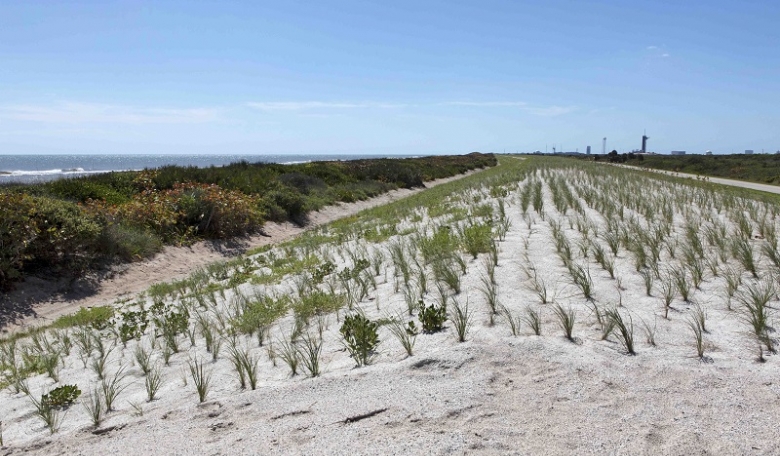Anthropogenic climate change and its associated rise in sea levels could prove a significant threat to some of the world’s iconic coastal space launch sites, including Florida’s Kennedy Space Center (KSC).
NASA is building a massive artificial dune along a stretch of the coast in a bid to protect the nation’s only launch site for human missions - but many experts say that ultimately it isn’t going to be enough.
Even conservative estimates suggest the low-lying Florida peninsula can expect to experience at least 5 to 8 inches of sea level rise by the 2050s, a figure which could double or treble if global warming is not contained at current levels.
Launch Complex 39A, the historic Apollo 11 and Space Shuttle launch pad that SpaceX now leases for its Falcon Heavy rocket, is one of the most vulnerable, as the base of the pad sits only a few feet above sea level and is just a quarter mile from the coastline.
This year, the pad 39A complex is estimated to face a 14 percent annual risk of flooding, a figure which is likely to rise unless additional measures are taken to protect it, according an analysis released in late 2019 by Climate Central, an international organisation researching and reporting the science and impacts of climate change.
Predictions are equally uncertain for launch complex 39B, the future home of NASA’s SLS rocket which will be used to launch the first people to the Moon by 2024. The current annual flood risk, estimated at six percent, is likely to double within two decades.
It is unclear how much damage sea floods could cause to the actual launch pads but, at the minimum, rising water could isolate the complexes as inaccessible islands, also threatening support roadways and other infrastructure.
At the same time, natural barriers along the coastline are also eroding. Based on historical records and aerial photos, the beach in front of the Cape Canaveral area has thinned and moved inland by as much as 200 feet. Losses have been most severe along the stretch near pads 39A and 39B.
NASA biologist Don Dankert, technical lead for KSC’s environmental planning office, is charged with protecting the agency’s valuable launch assets. “Climate change is obviously important to the agency,” he says. “Looking into the future and how we address this with our infrastructure in our inland areas is a top priority.”
After studying various engineering solutions, Dankert and his team settled on constructing hefty inland sand dunes as a barrier between Florida’s launch pads and the encroaching ocean.
AS a result, NASA is currently using 350,000 cubic yards of sand to build a 3.2 mile-long dune 17 feet high and 90 feet wide. The sand is being trucked from an inland source and is matched to the sand that is on local beaches for grain texture and size consistency. Once complete the dune will be covered with native vegetation to help maintain its integrity.
But as global temperatures continue to climb and with forecasters warning of more frequent and stronger hurricanes, not everyone is convinced. Joseph Donoghue, an ocean sciences professor at the University of Central Florida, is assessing the effects of major storms on coastal environments at the National Center of Integrated Coastal Research.
“Sure, dunes are a good short-term solution. But the dunes are only good for as long as no major hurricanes come through,” he says. “Long-term, dunes aren’t going to do the job.”
NASA reckons the $35 million it is spending on the shoreline restoration project, which is expected to be completed by the end of the year, is money well spent. But according to Leesa Souto, Executive Director of the Marine Resources Council and Assistant Professor of Ocean Engineering at Florida Institute of Technology, sand dunes and sea walls only protect against storm surges and do not address flooding from rising groundwater.
“It's not just flooding from the ocean that we are concerned about; a rising sea level also increases pressure inland, causing the groundwater to rise,” she explains. “The launch pads are particularly vulnerable because they are out on a peninsula in the middle of the ocean between the estuary and the ocean.”
"Ground water is sea level so when sea level rises, ground water rises. So when the elevation of the land and the elevation of groundwater are the same, you have a lake," she added.
“So, unless they’re going to build the launch pads on the top of the 17 foot dune they are going to be under water.”
The Jeff Bezos-led Blue Origin commercial spaceflight company, which is pumping a billion dollars into the Space Coast area as a launch base for its New Shepard rocket, is taking no chances. The company leases Launch Complex 36 and is currently building it both out and upwards. “The base of our rocket will be 50 feet above the ground, which is 20 feet above the 100 year flood plain,” says Scott Henderson, Blue Origin's vice president of test and flight operations.
For an industry that routinely talks about its costs in millions, the billion dollar question remains: how viable will Kennedy Space Center be in the future? Florida’s Space Coast economy, which earns around $3 billion a year from ‘space’, is certainly banking on its success as long as possible.
But Blue Origin's Henderson envisions a time when there will be thousands of spaceports across the world and that, ultimately, Cape Canaveral may prove to have been just a starting point for human space exploration. “Today we’re constrained to coastal areas but in the long haul you need to be flexible and reliable enough to fly from lots of places," he says.











